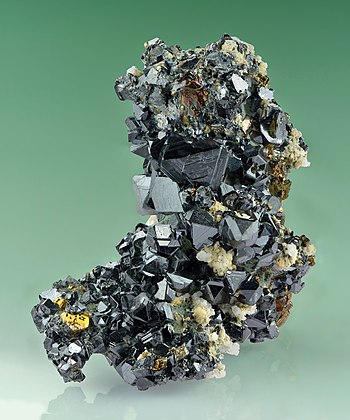Talk:Sphalerite
| This It is of interest to the following WikiProjects: | ||||||||||||||||||||||||||||||||||
| ||||||||||||||||||||||||||||||||||
Wiki Education Foundation-supported course assignment
[edit]![]() This article was the subject of a Wiki Education Foundation-supported course assignment, between 14 January 2021 and 11 April 2021. Further details are available on the course page. Student editor(s): Laurenmacky. Peer reviewers: LisaTruong3, EmlyCole.
This article was the subject of a Wiki Education Foundation-supported course assignment, between 14 January 2021 and 11 April 2021. Further details are available on the course page. Student editor(s): Laurenmacky. Peer reviewers: LisaTruong3, EmlyCole.
Above undated message substituted from Template:Dashboard.wikiedu.org assignment by PrimeBOT (talk) 10:00, 17 January 2022 (UTC)
Untitled
[edit]Adopted orphan redirects for Google: false galena, mock lead, black-jack ore
- This material's crystal structure happens to be the prototype for all commercial compound semiconductors. I might eventually want to calve off the zincblende and zinc blende redirect pages into an article on general properties of this crystal structure, with a navigational aid at the top linking to this mineralogy page. Otherwise, lots of materials scientists might come traipsing through here looking for info on GaAs, AlGaAs, InGaP, ...--Joel 00:00, 17 May 2005 (UTC)
- The lustre of sphalerite is submetallic, rather than resinous as was previously stated in the article. It is listed in the submetalic lustre category. --turkeybrain 02:54, 21 August 2008 (UTC)
- Most refs (Webmineral, Mindat) state adamantine to resinous (esp. for low iron), but high Fe varieties verge on submetallic (Dana's Manual). Vsmith (talk) 03:31, 21 August 2008 (UTC)
- Shouldn't we add some basic chemical data such as melting point, solubility in water etc.? —Preceding unsigned comment added by 194.53.253.51 (talk) 14:51, 18 November 2009 (UTC)
- Second that, especially since I'm told that sphalerite has no melting point, subliming at 1185 C. This seems like a pretty interesting property to me. 98.221.97.100 (talk) 19:15, 27 December 2010 (UTC)
See zinc sulfide. Sphalerite is mostly ZnS, but impurities/other phases (whose presence is common for most minerals) would change its properties, such as melting. Perhaps this is a reason why they are not listed in the mineral articles. Materialscientist (talk) 00:01, 28 December 2010 (UTC)
Uses of Sphalerite
[edit]I have added a "Uses" heading for sphalerite but it requires more information and is a major gap in the article that needs to be filled in. Laurenmacky (talk) 01:34, 18 March 2021 (UTC)
Reorganization of sections
[edit]I have changed the "chemistry" heading to "crystal habit and structure", and then added a new heading on "properties"; the information from the original chemistry heading has been split into these new ones. Additionally, I have merged the "economic importance" and "gemstone" headings under a new one titled "uses" because there was not enough information in them to remain separate. There is a gap in information about how sphalerite is mined and turned into zinc that should be added as a new section.Laurenmacky (talk) 01:38, 18 March 2021 (UTC)
Strange contradiction with German version of article
[edit]This article says that "German geologist Ernst Friedrich Glocker discovered sphalerite in 1847, naming it based on the Greek word sphaleros, meaning "deceiving", due to the difficulty of identifying the mineral." - By contrast, the German langugage version of this article claims that the ore was understood to be a Zink ore in 1735 and that the name stuck around from before when it was already know but thought to be a misleading lookalike. Both claims are sourced. I have no clue which one is correct, but maybe someone else does and can look into this. — Preceding unsigned comment added by 2A01:C22:D152:6A00:294C:4CF2:FE53:9B82 (talk) 15:31, 22 September 2023 (UTC)
Featured picture scheduled for POTD
[edit]Hello! This is to let editors know that File:Sphalerite -_Creede,_Mineral_County,_Colorado,_USA.jpg, a featured picture used in this article, has been selected as the English Wikipedia's picture of the day (POTD) for April 29, 2024. A preview of the POTD is displayed below and can be edited at Template:POTD/2024-04-29. For the greater benefit of readers, any potential improvements or maintenance that could benefit the quality of this article should be done before its scheduled appearance on the Main Page. If you have any concerns, please place a message at Wikipedia talk:Picture of the day. Thank you! — Amakuru (talk) 15:58, 10 April 2024 (UTC)

|
Sphalerite is a sulfide mineral with the chemical formula (Zn,Fe)S. It is found in a variety of deposit types, and is found in association with galena, chalcopyrite, pyrite (and other sulfides), calcite, dolomite, quartz, rhodochrosite, and fluorite. Sphalerite is an important ore of zinc, with around 95 percent of all primary zinc extracted from its ore. Due to its variable trace-element content, sphalerite is also an important source of several other metals such as cadmium, gallium, germanium and indium. The zinc in sphalerite is also used to produce brass. This sample was extracted in Creede, Colorado, and features black tetrahedral crystals of sphalerite up to 8 mm (0.31 in) in size, with minor chalcopyrite and calcite, in a 4.5 cm × 3.0 cm × 2.0 cm (1.77 in × 1.18 in × 0.79 in) matrix. This photograph was focus-stacked from 125 separate images. Photograph credit: Ivar Leidus
Recently featured:
|
- Start-Class level-5 vital articles
- Wikipedia level-5 vital articles in Physical sciences
- Start-Class vital articles in Physical sciences
- Start-Class Mining articles
- High-importance Mining articles
- WikiProject Mining articles
- Start-Class Gemology and Jewelry articles
- Low-importance Gemology and Jewelry articles
- WikiProject Gemology and Jewelry - Gemstones
- WikiProject Gemology and Jewelry articles
- Start-Class Rocks and minerals articles
- Mid-importance Rocks and minerals articles
- Mid-importance Start-Class Rocks and minerals articles
- WikiProject Rocks and minerals articles




